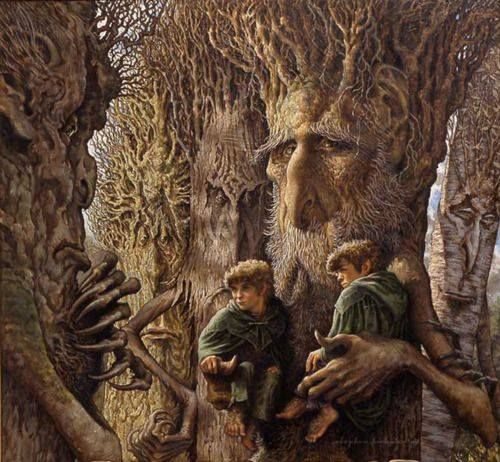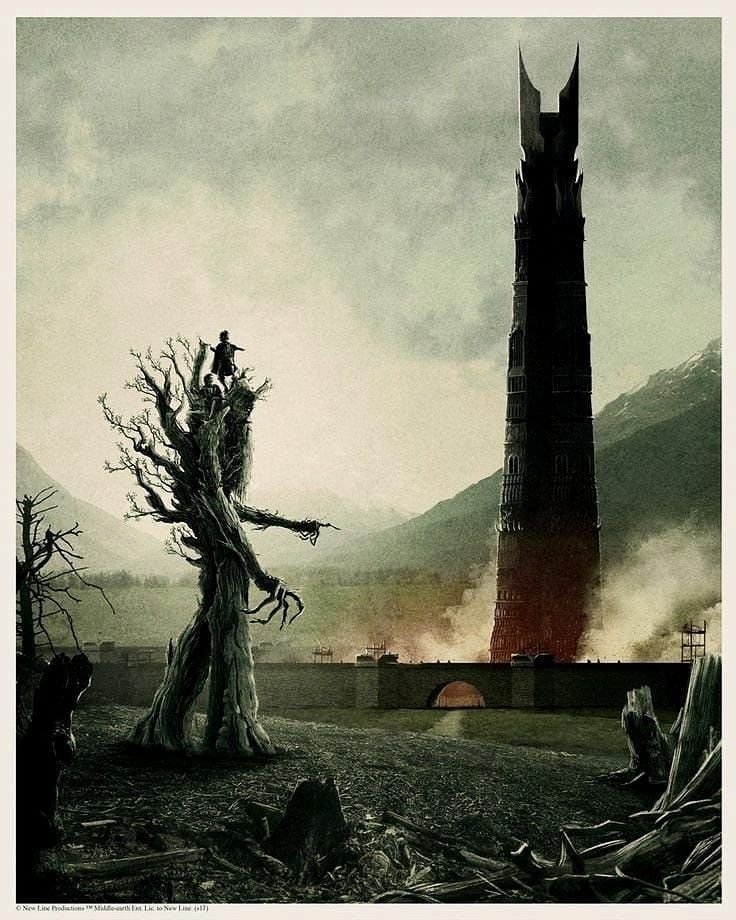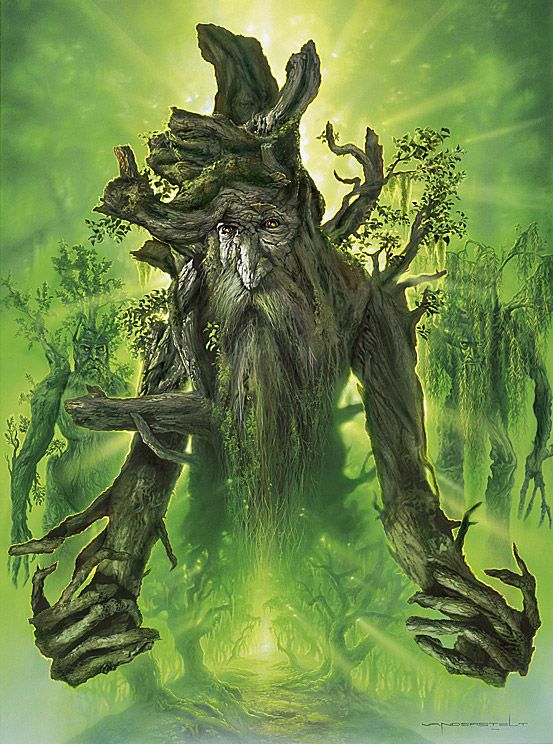Treebeard is an Ent, featured in Tolkien’s Middle Earth, and plays a pivotal role in The Two Towers (both book and movie franchise).
Treebeard resides in Fangorn Forest, is the leader of the Ent Folk, and minder of the trees in his domain. His speech in the common tongue is quicker than this native Ent speech. Indeed, Treebeard was quoted to say this to Meriodoc “Merry” Brandybuck, regarding the length of time it takes Ents to converse or discuss anything during the Entmoot (meeting between Treebeard and other tree shepherds):

You must understand, young Hobbit, it takes a long time to say anything in Old Entish. And we never say anything unless it is worth taking a long time to say.
J.R.R. Tolkien, The Two Towers (The Lord of the Rings, #2)
After the Entmoot, Treebeard led the Ents to war with Saruman after finding Fangorn Forest harvested to fuel the corrupted wizard’s industrialized creation of the Urukai and weapons.
He is plotting to become a Power. He has a mind of metal and wheels; and he does not care for growing things ... He has taken up with foul folk, with the Orcs. ... Worse than that: he has been doing something to them; something dangerous. For these Isengarders are more like wicked Men. It is a mark of evil things that came in the Great Darkness that they cannot abide the Sun; but Saruman's Orcs can endure it, even if they hate it. I wonder what he has done? ... Down on the borders, they are felling trees — good trees. Some of the trees they just cut down and leave to rot — orc-mischief that; but most are hewn up and carried off to feed the fires of Orthanc. There is always a smoke rising from Isengard these days.
— The Two Towers, book 3, ch. 4 “Treebeard”
After the Urukai marched to war against the fractured Fellowship and Rohan at Helm’s Deep, the Ents raized the Orc underling’s war structures and the dammed Isen River in The Last March of the Ents.
"The filth of Saruman is washing away. Trees will come back to Isengard." —Treebeard

Treebeard was left in charge of Isengard and Fangorn Forest to restore order. During the Fourth Age, King Elessar (Aragorn) granted the entire Isengard valley to Treebeard and the Ent Folk. It was renamed Treegard of Orthanc. Orthanc tower was reclaimed by Middle Earth as part of the Reunited Kingdom of Gondor and Arnor.
Before the Events in Tolkien’s Trilogy
Treebeard’s first name is Fangorn (Sindarin for Beard (Fang) and Tree (orn), and therefore, Fangorn Forest was named after him. He is the oldest living creature in Middle Earth, he came to be during the Years of the Trees. He is the eldest of all the Ents. Treebeard is considered the oldest living creature in Middle Earth but Tom Bombadil is considered the oldest living being in Middle Earth, as Tom is “otherworldly” in Tolkien’s description.
Fangorn’s Ent-Wife is named Fimbrethil or Wandlimb. Like all the Ent-Wives and Ent-Maidens, she is lost. Lost as in Treebeard and the other Ents cannot remember where they are. They went missing sometime during the Second Age and at the time of the events in The Two Towers, it’s been over 3,000 years since Treebeard and Fimbrethil have seen each other.
“There have been no Entings – no children, you would say, not for a terrible long count of years. You see, we lost the Entwives.’
‘How very sad!’ said Pippin. ‘How was it that they all died?’
‘They did not die!’ said Treebeard. ‘I never said died. We lost them, I said. We lost them and we cannot find them.’ He sighed. ‘I thought most folk knew that. There were songs about the hunt of the Ents for the Entwives sung among Elves and Men from Mirkwood to Gondor. They cannot be quite forgotten.”
Crucial Role in The War of the One Ring
Treebeard led the revolt against Isengard and Sarumon, securing the Orthanc Tower in the process, led to the demise of Sarumon, and ending the corruption/destruction of Fangorn Forest and the surrounding area of Isen River and Valley.
Had Treebeard not heeded Merry and Pippin’s request to take them back to The Shire by walking South, by Isengard in Nan Curunín valley, and had he not decided to call on the Ent Folk to fight the evil of Saruman, the continued production of Urukai and weapons would have continued. Mordor’s forces would have annihilated the race of Men, Elves, & Dwarves. Treebeard’s securing one of the Two Towers led to a momentous and strategic win, especially considering it came from 2 “unlikely creatures” (hobbits) and the Ents, which were rumored to be uncaring about the plights of the other races in Middle Earth.
Tolkien’s Inspiration for Treebeard
Tolkien was very open about his love of nature, his hatred of war, and his disdain for the Industrial movement within the world. Following his harrowing experiences during World War I (between his loss of friends, and viewing first-hand the destruction of the natural world in favor of war essentials), Tolkien poured all of his desire to rid the world of the people in powerful positions who deemed nature as being a lesser priority, into Treebeard and the strength of the Ents.
See also: Tolkien was inspired to write the destruction of Isengard through his disappointment in Shakespeare’s MacBeth and how it portrayed a battle of tree-like disguises men used to march into battle against Dunsinane. As a young schoolboy disenchanted with this portrayal, Tolkien vowed to fix it in his own writings.
Trivia: Treebeard’s Unique Voice
Treebeard’s voice was inspired by C.S. Lewis’ booming voice. C.S. Lewis was a close friend of J.R.R. Tolkien and famously a part of the writer’s club, The Inklings at Oxford University.
John Rhys-Davies voiced Treebeard in Peter Jackson’s The Lord of the Rings Trilogy when he wasn’t portraying Gimli, Son of Glóin.
« Back to Glossary Index



